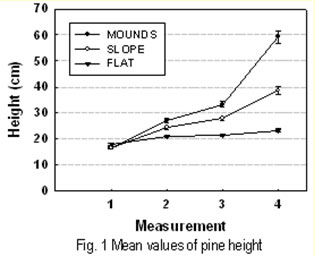- Home Page
- Composting
- Decomposition
Aims
Feedstock and Compost Mixes
Compost Production and Application - Land Restoration
- Quarry Sites
Urban Brownfield Sites
Mine Sites
Colliery Sites - Restoration results
- Quarry site - Blaenau Ffestiniog
Urban Brownfield site - Shotton
Mine site - Greece
Colliery site - Woolley Colliery - Dissemination and Publications
- Forthcoming Events
Previous Events
Open Days
TWIRLS Newsletters
Scientific Publications
Media Archive
Best Practice - Manuals and Tools - Information Services
- Best Practice - Manuals and Tools
- Our Staff

TWIRLS: Treating Waste for Restoring Land Sustainability
Site Restorations - Mine site - Greece
Site Restorations Menu
Using organic municipal waste compost to restore a degraded black schist quarry site near Athens, Greece.
Surface mining and extraction activities, which are widespread in Greece, cause intense changes to the landscape with resulting destruction of vegetation, soil and the natural landscape. At the same time, the lack of a sustainable approach in the handling and disposal of waste from human activities degrades the environment. An approach to contribute to the solution of both these problems has been applied to a schist quarry located in a mountainous area near Athens, in collaboration with TITAN Cement Company S.A., which has been exploiting the quarry for cement production.
 Photo 1: Poterium spinosum L.
Photo 1: Poterium spinosum L.
The black schist material is a very infertile substrate for plant growth, poor in organic matter and nutrients with low carbonate content and a pH of about 7.5. Many plant species as pines (Pinus halepensis Mill.), Poterium spinosum L., Genista acanthoclados D.C., Polypogon monspeliensis (L.) Desf., Plantago weldenii Reichenb. etc. contribute to the natural restoration of the degraded area (Photo 1). The site, at an altitude of 520 m, is exposed to cold winds and snow in winter and to the hot summer sun. Grazing in the area has also contributed to the slow rate of revegetation at the site.
 Photo 2: The experimental sites
Photo 2: The experimental sites
Three different areas within the quarry were selected representing 3 different topographies: a compacted, flat area with seasonal water logging (untreated control); a gently sloping, land formed area and artificially created mounds of overburden rock material formed on the flat area (Photo 2). Compost, produced from mixing municipal waste, green waste and digested sewage sludge at the recycling plant of the Association of Communities and Municipalities in the Attica Region (ACMAR), near Athens was used for nutrient amendment and texture improvement. The compost had an organic matter content of 32.6%, C/N ratio of 11.9, EC of 21.7 mS cm-1, pH of 7.0, carbonate content of 23.0% and a high concentration of plant available nutrients. Pine trees were pocket planted in 3 L of schist or compost mixed with schist at the rates of 1:2 and 2:1 by volume, in order to examine the effect of the addition of organic matter in the establishment of suitable vegetation on the infertile material.

Photo 3: Pine development in the mounds site
Tree establishment and survival were better on the mounds and sloping site, compared with the flat site (Photo 3). In order to assess tree health and development, height, main stem diameter and the number of secondary branches were measured every six months (Figure 1). Results for the 18th month period since the start of the experiment generally showed a markedly greater increase in these parameters for the trees with compost addition at planting. Although the rate of tree growth appeared to be greater with the lower rate of compost addition compared to the higher one, differences between the compost application rates were not significant.
 The company will continue the experiment and assessment of the results after the end of the project. To date it has been demonstrated that the application of compost at pine seedlings planting has enhanced seedling development on the sloping and mound sites and that pocket planting with compost to schist ratio of 1:2 provides conditions in which the seedlings can develop with a higher growth rate. The formation of mounds gives a solution to the problem of establishing tree growth in the compacted and waterlogged areas.
The company will continue the experiment and assessment of the results after the end of the project. To date it has been demonstrated that the application of compost at pine seedlings planting has enhanced seedling development on the sloping and mound sites and that pocket planting with compost to schist ratio of 1:2 provides conditions in which the seedlings can develop with a higher growth rate. The formation of mounds gives a solution to the problem of establishing tree growth in the compacted and waterlogged areas.
As a consequence of the encouraging results from this experiment, TITAN Cement Company S.A. plans to use a significant quantity of compost from the unit of ACMAR in its current environment rehabilitation programme.

